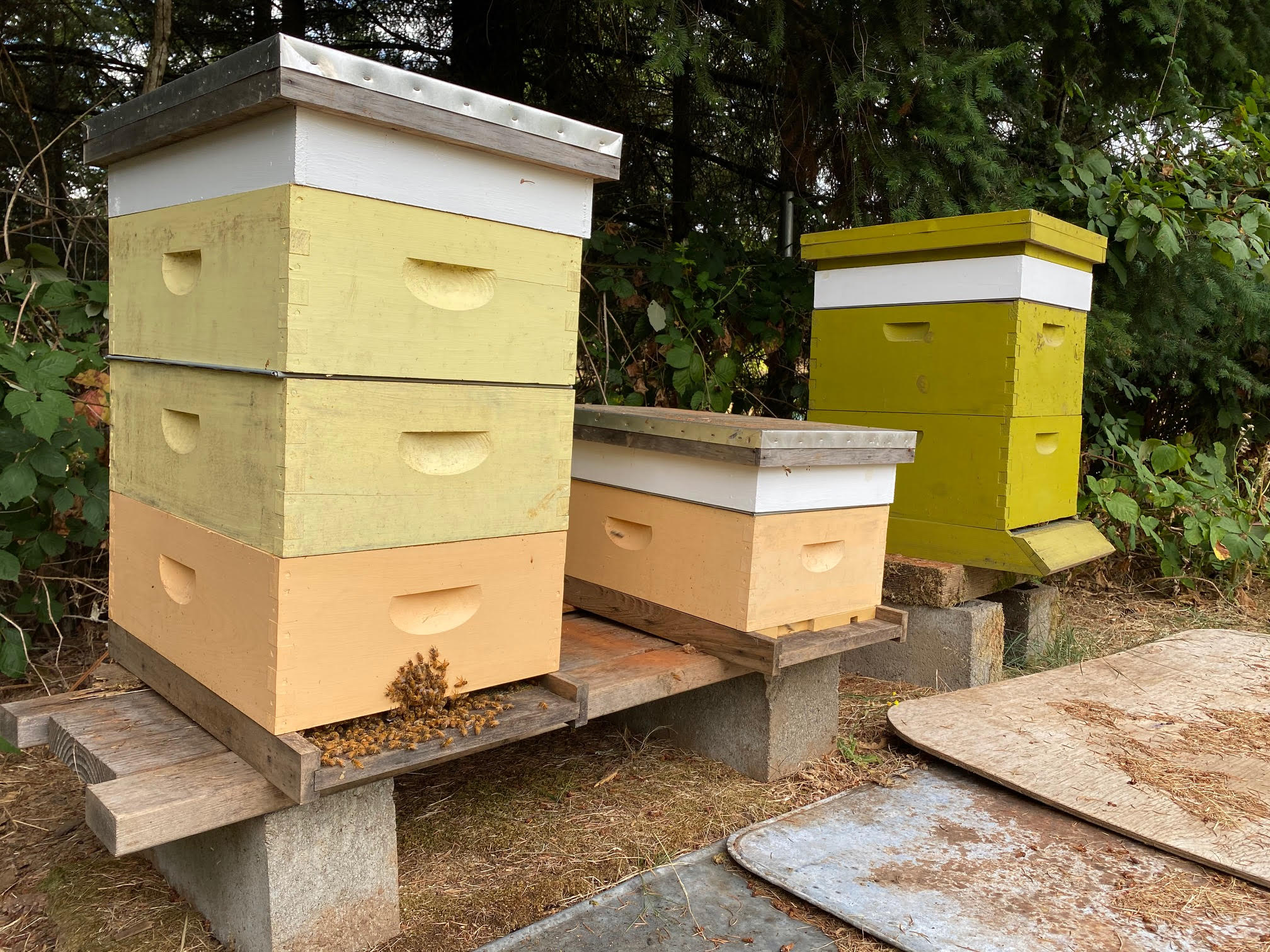August was definitely NOT a month for much hive examining. Temperatures were hot and hives full of bees (and maybe supers had some honey). September is a critical juncture in our annual mite fight – take samples NOW. A nice resource is the August BetterBEE Buzz (a bee supply newsletter) “Winter Bees and Varroa Mites”.

As you watch bees coming and going, do you see bees coming in with balls of pollen on their hind legs? This is good. It means the bees are foraging well. City/suburban bees will find pollen from watered lawns and yard/community plantings but those in the country might not. Look early morning for best opportunities to see incoming pollen. Look for a variety of colors. You might even be able to do a little detective work and figure out where they might be finding the pollen by looking where the bees are foraging by looking for the distinctive colors they are sporting.
Later in the day, you may see bees exiting the hive and hovering around the hive, flying up and down or in a figure eight. These bees are doing orientation flights. This is a good sign that the queen is healthy and laying eggs. It is however these bees learning where they live that will drift to nearby hives. Drifting bees come from brood nests areas and they may be bringing mites with them into your hives.
What you hope not to see are bees walking around apparently unable to fly. Check to see if the bees have deformed wings – if spotted then switch right away to a different or at very least consider ramping up your mite control plan of action. Deformed wings or shinny bees or bees crawling on structures (like blades of grass or hive stand) that seem unable to fly is not a good sign.
Looking closely, you will likely see guards – they are there to keep uninvited intruders out. They stand on hind 2 pair of legs with head, forelegs and antennae forward. You may witness challenges – two or more bees “wrestling” on the landing board or on the ground in front of the hive. We see this often during the fall when the nectar flow slows down and the bees are getting ready for winter. If you see one bee fly off, that is good – the guard bees are doing their job.
Hopefully no signs of robbing are present. This will show as lots of bouncing, circling bee flight and groups of bees seeking entry between the boxes, under the cover and flying before the entrance but not immediately into the entry in the fashion of foragers, Robbers can overwhelm the guards. To help weaker colonies, reduce the entrance size, eliminate alternate entrances and seriously consider a robbing screen. BeeKeepClub, an Amazon advertising affiliate, has information on robbing/moving screens with pros and cons of 10 best products. https://beekeepclub.com/best-beehive-moving-and-robbing-screens/
You might see undertaker bees doing their work in the fall. These bees will be dragging workers, the larger drones and bee brood from the hive. Look for heightened hive cleaning first thing in the morning. There might be a considerable amount of drone adults and brood; some of the drones might be still alive. This is the fall drone clean out and is necessary for the hive to rid itself of their drones to have chance to survive the winter.
While you’re observing the beehive entrance, do not forget to look down at the ground around the hive. There will probably be dead bees that the house bees have removed. This is perfectly normal. Over time you’ll get a good feel for normal amounts of dead. With drone cleansing the number of dead bodies will be heavier in the fall. Dead/dying bodies readily attract ants, beetles, flies and especially yellow jackets. The cycle of life continues even in death.
In late summer/fall you might observe bee bearding. Bee beards are a mass of bees hanging out on the outside of the hive or under the hive stand. Bees like to keep the hive around 95°F so during the heat of the summer, some bees may need to exit the hive and stay out for a while to cool off and allow the bees to fan their hive at the entrance to cool their home and/or lower carbon dioxide levels. It does not portent swarming or absconding. Normally no action is needed if you see bee bearding.
The Carolina Beekeeping website has a good explanation of bee bearding, including a great photo of washboarding on the front of a hive. Washboarding is an unusual form of bearding with spacing of bees and rhythmic back and forth rocking motions. We don’t know its significance – I think the bees are doing a form of line dancing – but I haven’t located the music source yet that coordinates their movements! https://carolinahoneybees.com/bee-bearding/
And speaking of looking around the hive. have you looked about the apiary site? Are there tree limbs that are dangling and need to be cut before our fall storms. Has grass grown high so bees have a tough entry/exit? Signs of skunks? Heavy numbers of yellow jackets noticed? We will begin to get rains in another month so are your hives weather and wind proofed? If you use an electrified bear fence is there anything that might short out your bear fence? Soon as the wild berries pass those male bears will be looking for a fall food source.
After our mild November last year, somewhat late spring with crazy wet (till mid-June), then hot summer lets hope fall brings more normal conditions and our bees collect the nectar resources to successfully overwinter.
